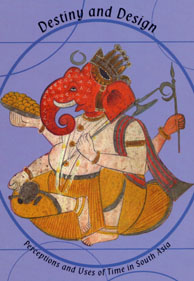opened by:
The Kalpa System of Time
David Pingree
The manuscripts and objects on display in the Rosenwald Gallery of the Van Pelt Library were selected to illustrate the intimate relationship between time and doctrine in three of the great religious traditions of South Asia: Hinduism, Buddhism and Jainism. How do the religious traditions of South Asia conceptualize time? How do these notions of time shape their social institutions and cultural practices? Each text from the various traditions of South and Southeast Asia reflects a particular facet of time: the measurement of time, the understanding of time, the interpretation of time, the use of time, the control of time, even timelessness itself. The exhibit dramatically evokes the extent to which perceptions of time are deeply rooted in cultural traditions.
To inaugurate the Indic Manuscripts Exhibition at the Van Pelt Library, Destiny and Design, David Pingree, the distinguished Old World scholar, Professor of Classics, and chair of the department of the History of Mathematics at Brown University, will present a discussion of the Kalpa system of time.
Pingree will trace the concept of the Kalpa as a long period of time from its first appearance in this sense in the third century BCE inscriptions of Aboka through its introduction into Western Europe in the eleventh century as an integral part of the Arabic version of Indian astronomy. At the beginning, it was used in a moral context as was also the related concept of the four yugas and the Jaina idea of the avasarpini and the utsarpini. The Kalpa and the yugas that were incorporated into it were given numerical values in the first centuries CE; they appear in the Epics and the Purinas as a framework for universal history and a description of the evils of the current age. The numbers of years assigned to the various components of the Kalpa as to their sum, the Kalpa itself, seem to be Babylonian in origin. The mathematical Kalpa was adapted in the fifth century to the problem of computing the mean motions of the planets by Indian scientists transforming the spherical astronomy of the Greeks to their own uses; these Indian Scientists were influenced in this by ideas that can be traced to Plato.
The Buddhists made their own adaptation of the mathematicized Kalpa and through their writings it spread through Central and East Asia, while both the astronomical and the Buddhist traditions carried it to Southeast Asia. Sasanian scientists brought the astronomical version to Iran in the fifth century, and both the resulting Pahlavi and Sanskrit texts from Sind transmitted it in the late eighth century to the earliest Arabic astronomers in Baghdad. It reached Spain in the so-called Sindhind tradition of Arabic astronomy by the middle of the ninth century, at about the same time Abu Ma'shar in Baghdad adopted it for use in the Sasanian theory of historical astrology. In the twelfth century both the astronomical and the astrological forms of mathematical Kalpa appeared in Latin, Greek, and Hebrew. Religion and science combined to carry to carry this Indian concept of time to all corners of Eurasia as well as North Africa; it is one of the common concepts in a very widespread Eurasian culture that is much indebted to India, though often in ways we no longer recognize



